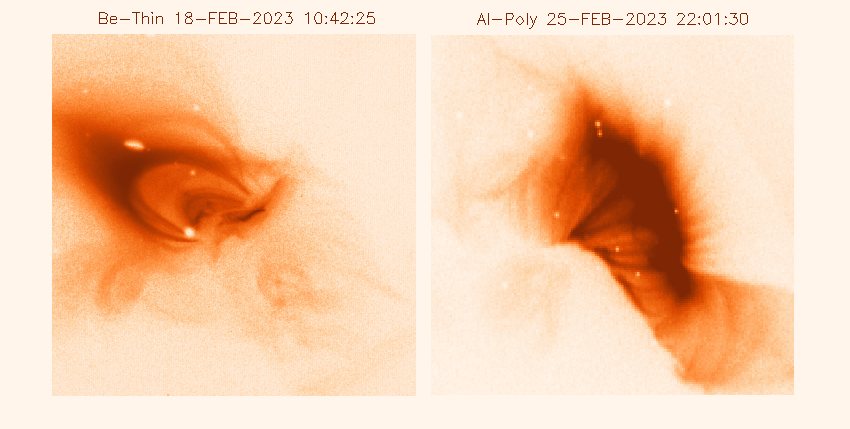
Flares and other activity observed from AR13229. Click the above image to watch
or click here for the youtube version.
Cusp and Arcades of AR13229
|
Active Region 13229 came around the East limb with a bang. Not only did this active region draw attention from its explosive entrance, an X2.2 flare, the region developed a gorgeous cusp that would glow into the following days. This first CME hit Earth with a glancing blow. The resulting CME from the X2.2 flare can be seen here. The video linked to the above image shows the evolution of AR13229 over Feb. 18th to 19th. To start, the video was made with a short cadence with a single filter. Cadence refers to the number of images taken in a certain amount of time; which in this case is 1 image per 8 seconds. Over the 16 hours of observation, that's over 5600 images! The video only contains a quarter of those images. The filter, thin-Be, was used to capture the intricate arcades. There are also two unique features seen in the video: exposure time change and contamination of the CCD. The exposure time change is seen often in this video as a result of small flares happening below the arcades. They will appear dark and show up quickly at the base of the arcades. When the blotches appear, notice that the arcades fade and then reappear once the flare is over. XRT can automatically change exposure time to not burn the sensors. Finally, the white spots that don't move are contamination of the CCD. Space isn't as empty as movies show, there's debris in orbit and local space "dust". Eventually, there is build up on the instruments. The spots are usually edited out but this video is a special case. Although AR13229 eventually began to decay, it was not fully done flaring yet. Just before reaching the West Limb, AR13229 produced an M3.7 class flare, a C8.0 class flare, and an M6.3 class flare. We created another video of the final flares of AR13229 from Feb. 24 through Feb 25. This video was generated using the Al-poly filter. This filter is excellent at caputuring the evolution of the flares as they erupt. The subsequent CME from the M3.7 flare resulted in a G3 level geomagnetic storm. This means that the storm was strong, with a Kp index of 7, and could cause intermittent problems with HF radio and low-frequency radio navigation. This event also generated high to mid latitude aurora with stunning greens and reds. The CME from the M3.7 flare can be seen by clicking here. Credit to George Mason University SEEDS Coronagraph database. Keywords: Flare, CME Filters: Thin_Be, Al_Poly |
(Prepared by Rhiannon Fleming and Aki Takeda)
The XRT instrument team is comprised of SAO, NASA, JAXA, and NAOJ.
| Back | Archive | Next |